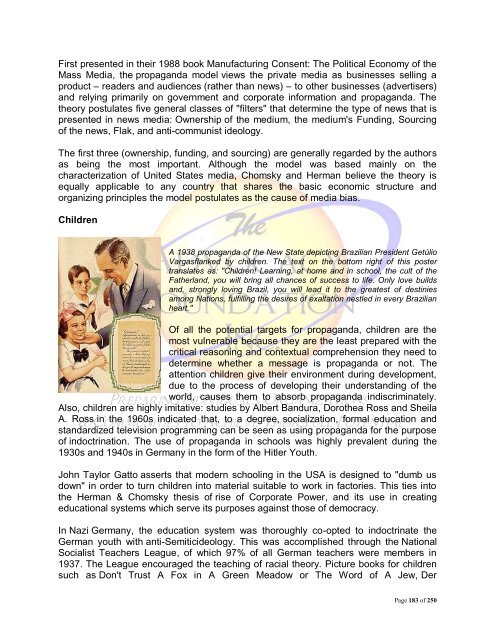Institutional Racism
Institutional Racism
Institutional Racism
You also want an ePaper? Increase the reach of your titles
YUMPU automatically turns print PDFs into web optimized ePapers that Google loves.
First presented in their 1988 book Manufacturing Consent: The Political Economy of the<br />
Mass Media, the propaganda model views the private media as businesses selling a<br />
product – readers and audiences (rather than news) – to other businesses (advertisers)<br />
and relying primarily on government and corporate information and propaganda. The<br />
theory postulates five general classes of "filters" that determine the type of news that is<br />
presented in news media: Ownership of the medium, the medium's Funding, Sourcing<br />
of the news, Flak, and anti-communist ideology.<br />
The first three (ownership, funding, and sourcing) are generally regarded by the authors<br />
as being the most important. Although the model was based mainly on the<br />
characterization of United States media, Chomsky and Herman believe the theory is<br />
equally applicable to any country that shares the basic economic structure and<br />
organizing principles the model postulates as the cause of media bias.<br />
Children<br />
A 1938 propaganda of the New State depicting Brazilian President Getúlio<br />
Vargasflanked by children. The text on the bottom right of this poster<br />
translates as: "Children! Learning, at home and in school, the cult of the<br />
Fatherland, you will bring all chances of success to life. Only love builds<br />
and, strongly loving Brazil, you will lead it to the greatest of destinies<br />
among Nations, fulfilling the desires of exaltation nestled in every Brazilian<br />
heart."<br />
Of all the potential targets for propaganda, children are the<br />
most vulnerable because they are the least prepared with the<br />
critical reasoning and contextual comprehension they need to<br />
determine whether a message is propaganda or not. The<br />
attention children give their environment during development,<br />
due to the process of developing their understanding of the<br />
world, causes them to absorb propaganda indiscriminately.<br />
Also, children are highly imitative: studies by Albert Bandura, Dorothea Ross and Sheila<br />
A. Ross in the 1960s indicated that, to a degree, socialization, formal education and<br />
standardized television programming can be seen as using propaganda for the purpose<br />
of indoctrination. The use of propaganda in schools was highly prevalent during the<br />
1930s and 1940s in Germany in the form of the Hitler Youth.<br />
John Taylor Gatto asserts that modern schooling in the USA is designed to "dumb us<br />
down" in order to turn children into material suitable to work in factories. This ties into<br />
the Herman & Chomsky thesis of rise of Corporate Power, and its use in creating<br />
educational systems which serve its purposes against those of democracy.<br />
In Nazi Germany, the education system was thoroughly co-opted to indoctrinate the<br />
German youth with anti-Semiticideology. This was accomplished through the National<br />
Socialist Teachers League, of which 97% of all German teachers were members in<br />
1937. The League encouraged the teaching of racial theory. Picture books for children<br />
such as Don't Trust A Fox in A Green Meadow or The Word of A Jew, Der<br />
Page 183 of 250

















